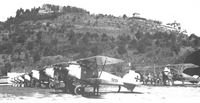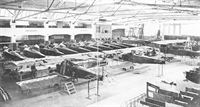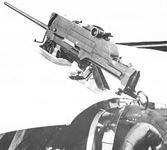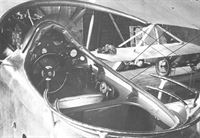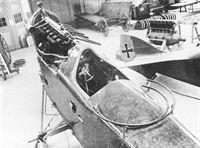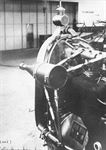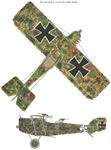
Описание
Страна: Австро-Венгрия
Год: 1917
Фронтовой самолет
В.Кондратьев Самолеты первой мировой войны
АВИАТИК (БЕРГ) C-I / AVIATIK (BERG) C-I
Австрийская авиастроительная фирма Авиатик ГмБХ (филиал одноименной немецкой фирмы) на раннем этапе Первой мировой войны выпускала двухместные разведчики B-II и B-III, примерно аналогичные "Авиатикам" C-I германского производства.
В начале 1917 года главный конструктор этого предприятия Юлиус фон Берг спроектировал оригинальный многоцелевой аэроплан "Авиатик-Берг" C-I.
Эта машина во многом повторяла созданный тем же автором истребитель "Авиатик" D-I, отличаясь увеличенной кабиной на двух человек с дуговой горизонтальной полутурелью для пулемета "Шварцлозе".
Испытания прошли в целом успешно. Летчики позитивно оценивали скоростные данные машины. Правда, из-за довольно большой по тем временам нагрузки на крыло самолет долго разгонялся на взлете и обладал сравнительно высокой посадочной скоростью. Это затрудняло работу "Авиатиков" с коротких прифронтовых ВПП.
Тем не менее C-I признали удачным и запустили в производство сразу на нескольких заводах: Авиатик (серии 37 и 137), Ллойд (серия 47), Лёнер (серии 114 и 214), WKF (серии 83 и 183) и MAG (серия 91). Всего построено более 500 экземпляров машины.
"Авиатик" C-I, чаще называвшийся по фамилии автора "Берг двухместный", активно применялся в 1917-1918 годах на итало-австрийском фронте. Первоклассные пилоты высоко ценили эту миниатюрную короткокрылую машину. Летчики же средней квалификации, напротив, предпочитали ей более простые в управлении, хотя и не столь проворные "Бранденбурги".
В марте 1918-го появилась одноместная фоторазведывательная модификация "Авиатика" C-I без вооружения, почему-то не получившая никакого специального обозначения. Помимо фотокамер эти самолеты комплектовались радиостанциями.
ДВИГАТЕЛЬ
"Австро-Даймлер", 185 л.с. (серии 37, 47, 83, 91 и 114) или - 200 л.с. ( серии 137, 183 и 214).
ВООРУЖЕНИЕ
Первоначально - 1 подвижный "Шварцлозе" на горизонтальной дуге или на шкворне в задней кабине и 1 курсовой в специальном деревянном контейнере над верхним крылом для стрельбы поверх винта.
На более поздних экземплярах, 1918 года выпуска, обычно ставили кольцевую турель Шнейдера и синхропулемет над мотором.
ЛЕТНО-ТЕХНИЧЕСКИЕ ХАРАКТЕРИСТИКИ
(с двигателем 200л.с.)
Размах, м 8,4
Длина, м 7,6
Сухой вес, кг 650
Взлетный вес, кг 865
Скорость максимальная, км/ч 186
Время набора высоты, м/мин 1000/3,5
Потолок, м 6400
Описание:
- В.Кондратьев Самолеты первой мировой войны
- P.Grosz, G.Haddow, P.Shiemer Austro-Hungarian Army Aircraft of World War One (Flying Machines)
- E.Hauke, W.Schroeder, B.Totschinger Die Flugzeuge der k.u.k. Luftfahrtruppe und Seeflieger 1914-1918
Фотографии
-
P.Grosz, G.Haddow, P.Shiemer - Austro-Hungarian Army Aircraft of World War One /Flying Machines/
Aviatik C.I 37.11, Flik 23
-
P.Grosz, G.Haddow, P.Shiemer - Austro-Hungarian Army Aircraft of World War One /Flying Machines/
Aviatik C.I 37.16, Flik 101/G
-
J.Herris - Aviatik Aircraft of WWI /Centennial Perspective/ (10)
Austro-Hungarian Aviatik (Berg) C.I 37.46 assigned to Flik 46.
-
P.Grosz, G.Haddow, P.Shiemer - Austro-Hungarian Army Aircraft of World War One /Flying Machines/
Aviatik C.I 137.01, Flik 50/D
-
P.Grosz, G.Haddow, P.Shiemer - Austro-Hungarian Army Aircraft of World War One /Flying Machines/
Aviatik C.I 137.24, Flik 21/D
-
В.Обухович, А.Никифоров - Самолеты Первой Мировой войны
Авиатик (Берг) С I
-
P.Grosz, G.Haddow, P.Shiemer - Austro-Hungarian Army Aircraft of World War One /Flying Machines/
Aviatik C.I(Lo) 214.07, Flik 22/D
-
J.Herris - Aviatik Aircraft of WWI /Centennial Perspective/ (10)
Austro-Hungarian Aviatik (Berg) C.I 214.07 assigned to Flik 22.
-
В.Кондратьев - Самолеты первой мировой войны
"Авиатик (Берг)" С-I, 22 эскадрилья ВВС Австро-Венгрии, весна 1918г.
-
E.Hauke, W.Schroeder, B.Totschinger - Die Flugzeuge der k.u.k. Luftfahrtruppe und Seeflieger 1914-1918
Aviatik-Berg C.I 37.06 in Aspern, Erprobung, die Seitenflosse entspricht noch nicht der Serienausfuhrung
Aviatik-Berg C.I 37.06 в Асперн, тестирование, киль еще не соответствует серийной версии -
P.Grosz, G.Haddow, P.Shiemer - Austro-Hungarian Army Aircraft of World War One /Flying Machines/
The Aviatik C.I 37.06, one of the four pre-production machines, photographed at Aspern during flight testing in April-May 1917.
-
P.Grosz, G.Haddow, P.Shiemer - Austro-Hungarian Army Aircraft of World War One /Flying Machines/
Compared to the final production version, the Aviatik C.I 37.06 had a slightly smaller fin and rudder. The C.I was powered by a 185 hp Daimler engine.
-
P.Grosz, G.Haddow, P.Shiemer - Austro-Hungarian Army Aircraft of World War One /Flying Machines/
Seen here at Aspern in May 1917, the last pre-production Aviatik C.I 37.07 also was fitted with a modified fin and rudder. Barely visible is the Type II VK gun canister mounted on the upper wing for flight tests.
-
P.Grosz, G.Haddow, P.Shiemer - Austro-Hungarian Army Aircraft of World War One /Flying Machines/
With few exceptions, the forward armament consisted of a free-firing machine gun mounted on the top wing and firing at a 15 degree angle over the propeller. Here the Schwarzlose gun of Aviatik C.I 37.11 is being adjusted.
-
P.Grosz, G.Haddow, P.Shiemer - Austro-Hungarian Army Aircraft of World War One /Flying Machines/
Had the Knoller episode not occurred, it is possible the Aviatik C.I would have arrived at the Front in 1916, rather than mid-1917. Aviatik C.I 37.13 was one of the early production machines.
Aviatik-Berg C.I 37.13 in Aspern, Erprobung, Serienausführung
Aviatik-Berg C.I 37.13 в Асперн, испытания, серийное производство -
P.Grosz, G.Haddow, P.Shiemer - Austro-Hungarian Army Aircraft of World War One /Flying Machines/
The two-seat Aviatik C.I 37.16 configured as a single-seat fighter by decking over the observer's position. Many of the C.I machines converted to photo fighters would have looked like this. Originally the aircraft was supplied to Flik 48 on 30 June 1917. It was attached to Flik 101/G in March 1918 as an escort fighter.
-
C.Owers - Hansa-Brandenburg Aircraft of WWI. Volume 1 - Landplanes /Centennial Perspective/ (17)
The Oeffag-built Albatros D.III was the preferred fighter of the kuk. Here Albatros fighters are lined up in front of Aviatik Berg D.I fighters (C.I ???) and a lone Brandenburg D.I. The steep terrain was typical of that flown in the Italian front.
Другие самолёты на фотографии: Albatros (Oeffag) D.II / D.III - Австро-Венгрия - 1917Hansa-Brandenburg D.I/KD - Германия - 1916
-
P.Grosz, G.Haddow, P.Shiemer - Austro-Hungarian Army Aircraft of World War One /Flying Machines/
Eight Albatros D.lIl(Oef) fighters of Jagdstaffel Oberleutnant Elssler parading on the Pergine airfield awaiting Kaiser Karl's inspection on 14 September 1917. A Brandenburg D.I(Ph) series 28 fighter and two Aviatik C.I series 37 biplanes are in the second row. Villa Guila della Rosa is in the far right.
Другие самолёты на фотографии: Albatros (Oeffag) D.II / D.III - Австро-Венгрия - 1917Hansa-Brandenburg D.I/KD - Германия - 1916
-
P.Grosz, G.Haddow, P.Shiemer - Austro-Hungarian Army Aircraft of World War One /Flying Machines/
In beautiful surroundings, Aviatik C.I 37.17 of Flik 48/D was photographed with full armament in the autumn of 1917. It was flown as a singleseat photo-reconnaissance aircraft by Flik 46/P in March 1918.
-
P.Grosz, G.Haddow, P.Shiemer - Austro-Hungarian Army Aircraft of World War One /Flying Machines/
Aviatik C.I 37.37 was operational with Fliks 5/D, 35/D, and 49/D between February and May 1918. In September 1918 it was at Al-Ma factory in Prague for repair.
-
J.Davilla - Italian Aviation in the First World War. Vol.1: Operations /Centennial Perspective/ (73)
The (Berg) C.I was a fast two-seat reconnaissance airplane little larger than its D.I fighter stablemate.
-
E.Hauke, W.Schroeder, B.Totschinger - Die Flugzeuge der k.u.k. Luftfahrtruppe und Seeflieger 1914-1918
Aviatik-Berg C.I 37.37 bei der Flik 35D, St. Veit im Wippachtal (Isonzo-front), Herbst 1917, auf dem Originalphoto fälschlich als „Brandenburger Aufklärerapparat“ bezeichnet, MG-Einbau Muster 16 Tür den Piloten, für den Beobachter Muster 7/12 ohne Wasserjacke
Aviatik-Berg C.I 37.37, Flik 35D, Санкт-Файт-им-Виппахталь (фронт Изонцо), осень 1917 г., на исходной фотографии неправильно обозначен как «Бранденбургский разведывательный аппарат», у пилота пулемет образца 16, у наблюдателя образца 7/12 без водяной рубашки -
J.Davilla - Italian Aviation in the First World War. Vol.1: Operations /Centennial Perspective/ (73)
The Aviatik (Berg) C.I was one of the primary two-seat reconnaissance airplanes used by the Austro-Hungarian Empire. It was fast but fragile. The pilot's gun was fixed to fire over the propeller arc due to Austria's shortage of synchronizing gear.
-
E.Hauke, W.Schroeder, B.Totschinger - Die Flugzeuge der k.u.k. Luftfahrtruppe und Seeflieger 1914-1918
Aviatik-Berg C.I 37.40 bei der Flik 23D in Gardolo, interessant die MG-Halterung mittels Kugelpivot
Aviatik-Berg C.I 37.40, Flik 23D в Гардоло, интересна шкворневая пулеметная установка. -
В.Кондратьев - Самолеты первой мировой войны
"Авиатик" С-I серии 37 со шкворневой установкой в задней кабине и без курсового пулемета
-
K.Delve - World War One in the Air /Crowood/
One of the early production Austrian Aviatik C I two seat reconnaissance machines, used on the Italian Front in late 1917. The serial, 37.40, just visible on the fuselage, follows the Austro-Hungarian practice of using the first 2-digit group to denote the production batch, while the last two numbers signify the individual aircraft's place within the batch, in this case the 40th machine. Unlike the German system, there is no indication of the year in which construction took place. Sadly, little hard performance data survives on the type itself.
-
P.Grosz, G.Haddow, P.Shiemer - Austro-Hungarian Army Aircraft of World War One /Flying Machines/
Sporting full camouflage and unit insignia, Aviatik C.I 37.47 was attached to Flik 46/P at Prosecco from September 1917 to May 1918. The tail fin has been reinforced with wire bracing.
-
P.Grosz, G.Haddow, P.Shiemer - Austro-Hungarian Army Aircraft of World War One /Flying Machines/
Beginning with aircraft 37.49, a wooden ring turret was installed on production aircraft, shown here on Aviatik C.I 37.55 of Flik 22/D in May-June 1918. The additional drag cable running between the upper wing strut and lower engine cowling was a modification found on some late production aircraft.
-
P.Grosz, G.Haddow, P.Shiemer - Austro-Hungarian Army Aircraft of World War One /Flying Machines/
A medley of aircraft flown by Flik 23/D at Divacca on the Isonzo Front in mid-1917, headed by a Brandenburg C.I(U) 69.57, followed by a Brandenburg C.I(U) 129.46, an Aviatik C.I series 37, and four Brandenburg C.I biplanes flanking a Brandenburg D.I fighter.
Другие самолёты на фотографии: Hansa-Brandenburg C.I - Германия - 1915Hansa-Brandenburg D.I/KD - Германия - 1916
-
P.Grosz, G.Haddow, P.Shiemer - Austro-Hungarian Army Aircraft of World War One /Flying Machines/
Aircrew of Flik 50/D preparing for takeoff in Aviatik C.I 137.01 at San Martino on 17 May 1918. The fixed machine gun is a Schwarzlose M 7/12, the observer’s an M 16.
-
P.Grosz, G.Haddow, P.Shiemer - Austro-Hungarian Army Aircraft of World War One /Flying Machines/
The Aviatik hangar at Aspern provides a perfect backdrop for seven Aviatik aircraft undergoing flight and acceptance testing in the autumn of 1917. From the right are C.I 137.07, 30.24, 39.01, two D.I series 138, and a C.I.
Другие самолёты на фотографии: Aviatik (Berg) D.I - Австро-Венгрия - 1917
-
E.Hauke, W.Schroeder, B.Totschinger - Die Flugzeuge der k.u.k. Luftfahrtruppe und Seeflieger 1914-1918
Aviatik-Berg C.I 137.14, Flik 59D, Februar 1918, ausgerüstet mit vier-blättrigem Jaray-Propeller, Staffelzeichen
Aviatik-Berg C.I 137.14, Flik 59D, февраль 1918 г., оснащенный четырехлопастным пропеллером Jaray -
P.Grosz, G.Haddow, P.Shiemer - Austro-Hungarian Army Aircraft of World War One /Flying Machines/
An Aviatik C.I series 137 aircraft sporting a four-bladed propeller, a sure sign that it was powered by a 200 hp Daimler engine. The wooden gun ring was installed on all C.I series 137 aircraft beginning with machine 137.19.
-
E.Hauke, W.Schroeder, B.Totschinger - Die Flugzeuge der k.u.k. Luftfahrtruppe und Seeflieger 1914-1918
Aviatik-Berg D.II 39.01 in Aspern, Flugzeughalle von Aviatik. Erprobungsflugzeug, Herbst 1917, im Hintergrund Berg C.I 137.15 und Berg D.I Ba 38
Aviatik-Berg D.II 39.01 в Асперн, Ангар Aviatik. Экспериментальный самолет, осень 1917 г., на заднем плане Berg C.I 137.15 и Berg D.I Ba 38Другие самолёты на фотографии: Aviatik (Berg) D.I - Австро-Венгрия - 1917Aviatik (Berg) D.II - Австро-Венгрия - 1917
-
P.Grosz, G.Haddow, P.Shiemer - Austro-Hungarian Army Aircraft of World War One /Flying Machines/
The unarmed Aviatik D.II 39.01 in front of the Aviatik hangars at Aspern in the fall of 1917. The four-bladed propeller was usually matched with a 200 hp Daimler engine. Behind the tail is Aviatik C.I 137.15.
Другие самолёты на фотографии: Aviatik (Berg) D.I - Австро-Венгрия - 1917Aviatik (Berg) D.II - Австро-Венгрия - 1917
-
P.Grosz, G.Haddow, P.Shiemer - Austro-Hungarian Army Aircraft of World War One /Flying Machines/
Personnel of Flik 101/G posing with the Aviatik C.I 137.20 escort fighter. It was delivered in October 1917 to Flep 3 in Trient where it was converted to a single-seat fighter. It was armed with a single, wing-mounted Schwarzlose M 16 machine gun.
-
Z.Czirok - German Aircraft in Hungarian Service /Centennial Perspective/ (92)
MAG 90.05 flys in to land; MAG 90.03 is at right. (Peter M. Grosz collection/STDB)
Im Fluge Fokker V 22, am Boden Dreidecker 90.03, Aviatik-Berg D.I 92.14, Aviatik-Berg C.I-Baureihe 91, Ufag C.I-Flugzeug 161.01Другие самолёты на фотографии: Aviatik (Berg) D.I - Австро-Венгрия - 1917Fokker D.VII / V11 / V18 / V22 / V24 - Германия - 1917Fokker Dr.I (Fokker Dreidecker) / V4 / V5 / V7 - Германия - 1917UFAG C.I - Австро-Венгрия - 1917
-
P.Grosz, G.Haddow, P.Shiemer - Austro-Hungarian Army Aircraft of World War One /Flying Machines/
The Aviatik C.I (Lo) 114.13, 114.12, and 114.15 at Aspern undergoing acceptance testing. Forward armament, installed at the Front, consisted of a single, synchronized Schwarzlose machine gun or a Type II VK gun canister on the upper wing.
-
P.Grosz, G.Haddow, P.Shiemer - Austro-Hungarian Army Aircraft of World War One /Flying Machines/
The Aviatik C.I (Lo) 214.03 (middle) of Flik 46/P on the Cinto Caomaggiore airfield in May 1918. A four-bladed propeller (left) was often fitted to Aviatik C.I machines powered by the 200 hp Daimler engine.
-
P.Grosz, G.Haddow, P.Shiemer - Austro-Hungarian Army Aircraft of World War One /Flying Machines/
This Aviatik C.I(Lo) 214.11 was placed in service with a 185 hp Daimler engine instead of the 200 hp engine as planned. The machine was attached to Flik 49/D in May 1918 and written off at the field flying school in Campoformido in June. The barrel of the wing-mounted Schwarzlose gun is just visible.
-
P.Grosz, G.Haddow, P.Shiemer - Austro-Hungarian Army Aircraft of World War One /Flying Machines/
The Aviatik C.I(WKF) 83.03 on the Aspern airfield in early 1918.
-
P.Grosz, G.Haddow, P.Shiemer - Austro-Hungarian Army Aircraft of World War One /Flying Machines/
The Knoller C.II(WKF) 81.05. The large, single-piece celluloid windscreen was a WKF characteristic. In the background is the Aviatik C.I(WKF) 83.03 undergoing flight trials.
Другие самолёты на фотографии: Knoller B.I / C.I / C.II - Австро-Венгрия - 1915
-
P.Grosz, G.Haddow, P.Shiemer - Austro-Hungarian Army Aircraft of World War One /Flying Machines/
An Aviatik C.I(WKF) 183.07 (center), Knoller C.II(WKF) 81.06 (right) and at least 26 Aviatik C.I biplanes, including 83.13 and 83.07, being assembled in the modern WKF factory in the spring of 1918.
Другие самолёты на фотографии: Knoller B.I / C.I / C.II - Австро-Венгрия - 1915
-
J.Herris - Aviatik Aircraft of WWI /Centennial Perspective/ (10)
The Austro-Hungarian branch of Aviatik built the Aviatik (Berg) C.I, sometimes called the Berg C.I to distinguish it from the completely unrelated Aviatik C.I. Based on a slightly enlarged airframe compared to the Aviatik (Berg) D.I, the Aviatik (Berg) C.I was a fast, two-seat reconnaissance airplane. Some were converted to single-seat photo-reconnaissance airplanes that needed no escort due to their speed.
-
P.Grosz, G.Haddow, P.Shiemer - Austro-Hungarian Army Aircraft of World War One /Flying Machines/
The square boxes on the wing surfaces held sand for load testing of the Aviatik 30.16 in February-March 1917. Later brought up to production standard, the aircraft was redesignated Aviatik C.I 37.03.
-
P.Grosz, G.Haddow, P.Shiemer - Austro-Hungarian Army Aircraft of World War One /Flying Machines/
Developed strictly as an airborne weapon, the Schwarzlose M 16 machine gun mounted on the top wing of an Aviatik C.I 137.20 converted to a single-seat fighter by Fluggeschwader I (Flik 101/G). A thin cable is attached to the trigger mechanism and the cocking handle can be seen above the windscreen. A corn and V-sight is mounted on the left side.
-
P.Grosz, G.Haddow, P.Shiemer - Austro-Hungarian Army Aircraft of World War One /Flying Machines/
The well-padded cockpit of the Aviatik C.I (37.07?) reveals the control wheel, flight instruments, and engine throttle. On the fuselage side are the fuel inlet cap and entry step.
-
P.Grosz, G.Haddow, P.Shiemer - Austro-Hungarian Army Aircraft of World War One /Flying Machines/
An Aviatik C.I(WKF) converted to a photo-reconnaissance fighter at the WKF factory. The rear cockpit has been faired over, but the gun ring has been retained for re-conversion to a two seater if required. According to some reports, the gun ring fooled Allied fighter pilots into believing the aircraft was a two seater. In the background is the beautifully-faired tail of the WKF 80.04 prototype.
Другие самолёты на фотографии: WKF C-type / 80.03 / 80.04 - Австро-Венгрия - 1917
-
P.Grosz, G.Haddow, P.Shiemer - Austro-Hungarian Army Aircraft of World War One /Flying Machines/
A close-up view of the Sottoscope mounted on the engine and radiator support of the same Aviatik C.I(WKF) photo-fighter conversion.
-
P.Grosz, G.Haddow, P.Shiemer - Austro-Hungarian Army Aircraft of World War One /Flying Machines/
The Aviatik 30.14 prototype (new) after colliding with the Brandenburg B.I 05.26 on 9 February 1917. 30.14 has the original two-piece upper wing and center section cabane. The balanced rudder differed from the production C.I.
Другие самолёты на фотографии: Hansa-Brandenburg B.I / FD / LDD - Германия - 1914
-
P.Grosz, G.Haddow, P.Shiemer - Austro-Hungarian Army Aircraft of World War One /Flying Machines/
Photographs of the two-seater conversions in operational service are rare. The raised, streamlined deck covering the rear cockpit has been dislodged by the crash of Aviatik C.I 37.54 converted to a photo single seater. Attached to Flik 46/P, this aircraft was written off on 21 September 1918.
-
E.Hauke, W.Schroeder, B.Totschinger - Die Flugzeuge der k.u.k. Luftfahrtruppe und Seeflieger 1914-1918
Aviatik-Berg C.I, Flugzeugnummer 214.07; man beachte das Tarnmuster, Flik 22
Aviatik-Berg C.I, номер 214.07, Flik 22; обратите внимание на камуфляж
-
P.Grosz, G.Haddow, P.Shiemer - Austro-Hungarian Army Aircraft of World War One /Flying Machines/
Dated 3 November 1916, this factory drawing shows the Aviatik 30.15, one of the three C.I prototypes, in its original design configuration.
-
P.Grosz, G.Haddow, P.Shiemer - Austro-Hungarian Army Aircraft of World War One /Flying Machines/
Aviatik C.I 137.01, Flik 50/D
-
P.Grosz, G.Haddow, P.Shiemer - Austro-Hungarian Army Aircraft of World War One /Flying Machines/
Aviatik C.I(Lo) 214.07, Flik 22/D
-
P.Grosz, G.Haddow, P.Shiemer - Austro-Hungarian Army Aircraft of World War One /Flying Machines/
Aviatik C.I Series 37 and 137
-
В.Кондратьев - Самолеты первой мировой войны
"Авиатик (Берг)" С-I
























